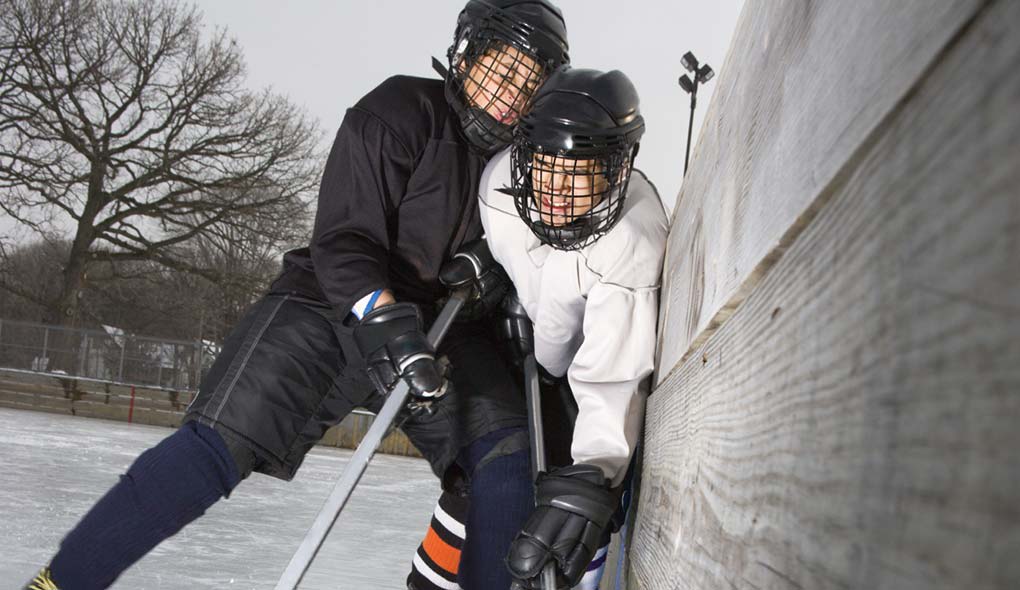5 Key Strategies to Taking a Check in Hockey

From the Pure Hockey Website – check them out!
Checking is an important part of the game at both ends of the ice in hockey, and a good, legal hit that separates a player from the puck is exciting to watch. For example, an effective check can stop an attack, keep the puck in the offensive zone, or cause a turnover that leads to a breakaway. Players in leagues where checking is allowed must learn to make a solid check and to effectively take a check from an opponent.
David A. Jensen, a former Olympian and NHL player who now owns and operates DAJ Hockey in Massachusetts says that his clinics on safe and effective body checking are among his most popular sessions. He argues that, like all hockey skills, reinforcement and practice of these checking techniques is vital to their becoming second nature to a player on the ice. Here are Jensen’s five keys to safely taking a check.
1. Keep Your Head Up and On a Swivel
Always skate with your head up and your head on a swivel, scanning the ice around you. One of the keys to any kind of on-ice safety is situational awareness. You must know what is going on around you and be aware of the other players near you. That way, you can anticipate any kind of contact, and be ready for it. The most dangerous kinds of checks—and the ones that can result in injury—are the ones where the player being checked doesn’t see it coming.
2. Take the Proper Angle to the Puck
To avoid a check that throws you into the boards—especially head first—approach the puck at an angle that doesn’t square your shoulders to the boards: Don’t skate straight at a puck that’s along the boards. Instead, when you’re about five feet from the puck, turn your body so you can pick up the puck at an angle such that any check will hit your outside hip and shoulder, rather than your back.
3. The Boards Are Your Friend
Although it may seem counterintuitive, it is safer to take a check when you are against the boards than it is to get hit several feet out from the boards. The boards provide a certain amount of give, lessening the impact, and the player making the check will usually bounce off. If you are off the boards just by a few feet, a check can throw you into them with a much bigger impact. Plus, being against the boards provides stability that will keep you on your feet. As Jensen puts it, “When you’re taking a check, the boards are your best friend.”
4. Maintain Your Hockey Stance
To protect yourself during a check, it is vital to maintain your hockey stance—with your knees bent and your weight centred. A common refrain to remember is, “Head up; Don’t duck.” By ducking, you throw off your balance, making yourself more likely to get hurt, and you may make your head the point of contact. The same goes for standing up. Although your impulse may be to stand more upright, you actually make yourself more vulnerable by doing this. A proper hockey stance is a solid, balanced foundation that will help you ride out the check safely.
5. Keep Skating
Although your impulse might be to slow down or stop to brace yourself for impact, you’re much more stable when you’re moving forward—just like it’s easier to stay up on a bicycle when you’re moving. It’s important that you continue to move your feet and skate through the check, which will put you in a much better position to get back in on the action afterward. As Jensen puts it, “Good skating is the foundation for every other hockey skill.”
Should Checking Be Allowed in Youth Hockey?
Maybe, although the introduction of checking in youth hockey is somewhat of a controversial topic. Over recent years, USA Hockey—the governing body for ice hockey in the United States—has pushed back the introduction of checking until the U14 level. This decision was intended to allow younger players to focus on developing good hockey skills and reducing injuries. But many coaches believe players would be better served to learn the proper checking techniques at a younger age, when they are less likely, because of their size, to cause injury through poor technique.
“When you get to the Bantam level, the size differences among players can be huge,” argues Jensen, “and with boys, testosterone levels are through the roof.” The result, he says, is that players are introduced to in-game checking in a situation where some players are built like adults, while others still look like kids. He believes that players should learn proper checking techniques earlier, so they are prepared for when size differences become more pronounced and the game becomes more aggressive.
There are pros and cons to each side of this argument—a simple Google search will provide hours of reading material—but no matter which camp you’re in, these five keys will help you play better and take checks more safely.
